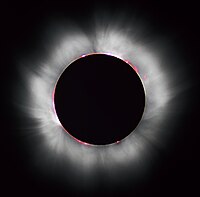
Photo from wikipedia
We present an analysis of 288 young stellar objects (YSOs) in the Perseus Molecular Cloud that have well defined g and r-band lightcurves from the Zwicky Transient Facility. Of the… Click to show full abstract
We present an analysis of 288 young stellar objects (YSOs) in the Perseus Molecular Cloud that have well defined g and r-band lightcurves from the Zwicky Transient Facility. Of the 288 YSOs, 238 sources (83% of our working sample) are identified as variables based on the normalized peak-to-peak variability metric, with variability fraction of 92% for stars with disks and 77% for the diskless populations. These variables are classified into different categories using the quasiperiodicity (Q) and flux asymmetry (M) metrics. Fifty-three variables are classified as strictly periodic objects that are well phased and can be attributed to spot modulated stellar rotation. We also identify 22 bursters and 25 dippers, which can be attributed to accretion burst and variable extinction, respectively. YSOs with disks tend to have asymmetric and non-repeatable lightcurves, while the YSOs without disks tend to have (quasi)periodic lightcurves. The periodic variables have the steepest change in g versus g-r, while bursters have much flatter changes than dippers in g versus g-r. Periodic and quasiperiodic variables display the lowest variability amplitude. Simple models suggest that the variability amplitudes of periodic variables correspond to changes of the spot coverage of 30% to 40%, burster variables are attributed to accretion luminosity changes in the range of L acc/L ∗=0.1−0.3, and dippers are due to variable extinction with AV changes in the range of 0.5−1.3 mag.
Journal Title: Research in Astronomy and Astrophysics
Year Published: 2023
Link to full text (if available)
Share on Social Media: Sign Up to like & get
recommendations!